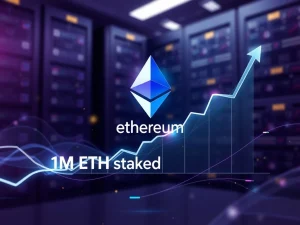Ethereum’s Explosive Ascent: Is $10,000 the Next Decisive Target?

The cryptocurrency world is constantly buzzing with audacious predictions, but few capture the imagination quite like the prospect of Ethereum (ETH) hitting a staggering $10,000. For many, this isn’t just a speculative fantasy; it’s seen as a tangible target, cementing Ethereum’s position as perhaps the easiest altcoin pick for significant returns. But what makes this forecast so compelling, and what forces could truly propel ETH to such heights? Let’s delve into the core reasons why the Ethereum price could be on a trajectory for five figures.
Why is Ethereum a Top Altcoin Pick?
When we talk about an ‘altcoin pick,’ we’re looking for projects with strong fundamentals, established ecosystems, and clear growth potential beyond Bitcoin. Ethereum stands head and shoulders above most contenders due to its unparalleled utility and network effect. It’s not just a digital currency; it’s the foundational layer for a vast decentralized internet.
- Dominant Ecosystem: Ethereum hosts the lion’s share of decentralized finance (DeFi) applications, non-fungible tokens (NFTs), and decentralized autonomous organizations (DAOs). This means a massive user base and developer community are actively building and transacting on the network.
- Constant Innovation: Ethereum is perpetually evolving. Major upgrades like ‘The Merge,’ which transitioned the network to a Proof-of-Stake consensus mechanism, significantly reduced its energy consumption and set the stage for future scalability improvements. Subsequent upgrades continue to refine its efficiency and capacity.
- Real-World Utility: Beyond speculation, Ethereum powers real-world use cases, from supply chain management to digital identity solutions. Its smart contract capabilities are transforming industries, making it more than just a digital asset.
Understanding Ethereum’s Price Potential
The journey to $10,000 for the Ethereum price isn’t merely a wish; it’s rooted in several fundamental economic and technological drivers. As the network matures and its adoption widens, the intrinsic value of its native token, ETH, naturally increases.
Key factors influencing this potential include:
- Supply-Demand Dynamics: Post-EIP-1559 and The Merge, a portion of transaction fees (base fee) is burned, permanently removing ETH from circulation. This deflationary pressure, combined with increasing demand from DeFi, NFTs, and staking, creates a powerful upward force on its value.
- Network Activity: The more transactions, smart contract executions, and DApp interactions occur on Ethereum, the more valuable the network becomes. Each new user, each new project, contributes to this growing network effect.
- Scalability Solutions: While Ethereum’s mainnet can face congestion, the rise of Layer 2 scaling solutions (like Arbitrum, Optimism, Polygon) is effectively expanding Ethereum’s capacity without compromising its security. These Layer 2s process transactions off-chain and then batch them onto the mainnet, making the overall Ethereum ecosystem more efficient and accessible.
Factors Driving ETH Prediction Towards $10,000
What specific catalysts could accelerate the ETH prediction towards the $10,000 mark? Several significant developments and market trends point in this direction.
The ongoing development roadmap, often referred to as ‘The Surge,’ ‘The Verge,’ ‘The Purge,’ and ‘The Splurge,’ aims to further enhance Ethereum’s scalability, security, and sustainability. These phased upgrades, particularly sharding, promise to dramatically increase transaction throughput, making Ethereum capable of handling global demand.
Furthermore, institutional interest is a game-changer. The approval of spot Bitcoin ETFs has opened the floodgates for traditional finance to access crypto. An Ethereum spot ETF, if approved, would provide a regulated and accessible investment vehicle for large institutions and retail investors, potentially injecting billions of dollars into the market. This influx of capital could be the decisive push needed to propel the Ethereum price significantly higher.
Historically, crypto markets move in cycles. Following a period of consolidation, strong fundamentals often lead to explosive growth. Ethereum, with its robust ecosystem and continuous innovation, is well-positioned to lead the next bull run.
Strategic Crypto Investment Approaches
For those considering Ethereum as a key component of their crypto investment portfolio, a strategic approach is crucial. While the $10,000 target is exciting, volatility remains a characteristic of the crypto market.
Here are some actionable insights:
- Dollar-Cost Averaging (DCA): Instead of trying to time the market, invest a fixed amount regularly (e.g., weekly or monthly). This strategy helps mitigate risk by averaging out your purchase price over time.
- Staking: If you hold ETH, consider staking it. Staking not only helps secure the network but also allows you to earn rewards on your holdings, effectively increasing your ETH stack over time.
- Research and Due Diligence: Understand the technology, the risks, and the long-term vision of Ethereum. Don’t invest based solely on hype or price predictions.
- Diversification: While Ethereum is a strong pick, a balanced crypto investment portfolio includes other assets to spread risk.
Pros and Cons of Investing in Ethereum (ETH)
| Pros | Cons |
|---|---|
| Dominant smart contract platform | Regulatory uncertainty |
| Vast DeFi and NFT ecosystem | Market volatility |
| Continuous technological upgrades (PoS, sharding) | Competition from other Layer 1s |
| Deflationary tokenomics (post-Merge) | Potential for network congestion (though L2s help) |
| Growing institutional adoption | Technical complexity for new users |
The Broader Blockchain Potential of Ethereum
Beyond its price action, the true long-term value of Ethereum lies in its transformative blockchain potential. Ethereum is not just a cryptocurrency; it’s a global, decentralized computer that can host any application. This vision extends far beyond finance.
- Web3 Foundation: Ethereum is a cornerstone of Web3, the next generation of the internet, where users have more control over their data and digital assets.
- Enterprise Solutions: Large corporations are exploring Ethereum-based solutions for supply chain transparency, digital identity, and tokenized assets.
- Global Accessibility: It offers financial services and digital ownership to anyone with an internet connection, fostering greater financial inclusion worldwide.
The network’s ability to evolve and adapt, coupled with its vibrant developer community, ensures its relevance and continued innovation in the rapidly expanding world of blockchain technology.
Conclusion
The journey to Ethereum at $10,000 is certainly ambitious, but it’s grounded in strong fundamentals, relentless innovation, and increasing mainstream adoption. As the leading smart contract platform, Ethereum continues to build out its infrastructure, attract developers, and expand its utility across diverse sectors. While market volatility and regulatory headwinds remain, the long-term outlook for ETH as a premier altcoin pick appears robust. For those looking to participate in the future of decentralized technology, understanding Ethereum’s potential is a crucial first step toward informed crypto investment.
Frequently Asked Questions (FAQs)
Q1: What makes Ethereum different from Bitcoin?
A1: While Bitcoin is primarily a digital store of value and a peer-to-peer electronic cash system, Ethereum is a decentralized platform that enables smart contracts and decentralized applications (DApps). ETH, its native cryptocurrency, fuels these operations, making Ethereum more of a programmable blockchain platform rather than just a currency.
Q2: Is $10,000 a realistic ETH prediction?
A2: Many analysts and market participants consider $10,000 a realistic long-term target for ETH, driven by factors such as network upgrades (e.g., sharding), increasing institutional adoption, the deflationary nature of ETH, and the continued growth of its DeFi and NFT ecosystems. However, like all predictions, it depends on various market and technological developments.
Q3: What are the main risks of investing in Ethereum?
A3: Key risks include market volatility, regulatory uncertainty, competition from other Layer 1 blockchains, potential technical vulnerabilities, and the broader macroeconomic environment. It’s essential to conduct thorough research and only invest what you can afford to lose.
Q4: How can I invest in Ethereum?
A4: You can buy Ethereum on various cryptocurrency exchanges (e.g., Coinbase, Binance, Kraken). You can also invest indirectly through crypto trusts or, potentially in the future, through spot Ethereum ETFs. Many investors use Dollar-Cost Averaging (DCA) to mitigate risk.
Q5: What are Layer 2 solutions for Ethereum?
A5: Layer 2 solutions are separate blockchains or protocols built on top of the Ethereum mainnet. They aim to increase transaction throughput and reduce fees by processing transactions off-chain and then settling them on the mainnet. Examples include Optimism, Arbitrum, and Polygon.
Q6: Will Ethereum’s energy consumption remain high?
A6: No. Ethereum transitioned from a Proof-of-Work (PoW) to a Proof-of-Stake (PoS) consensus mechanism with ‘The Merge’ upgrade. This change drastically reduced its energy consumption by over 99.9%, making it significantly more environmentally friendly than its PoW predecessor or Bitcoin.










